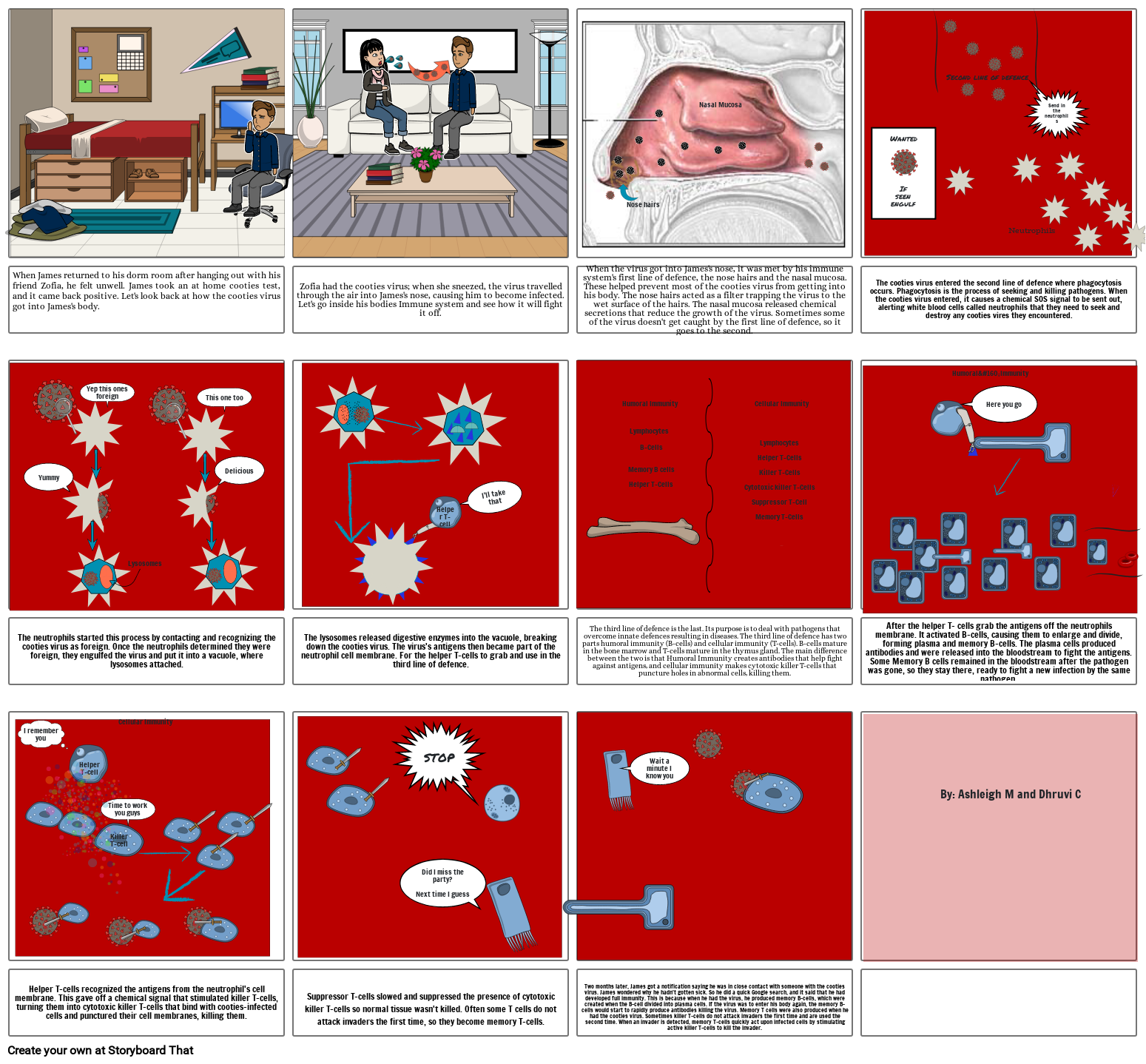The human immune system

Storyboard Text
- Nose hairs
- Nasal Mucosa
- Wanted
- If seen engulf
- Second line of defence
- Neutrophils
- Send in the neutrophils
- When James returned to his dorm room after hanging out with his friend Zofia, he felt unwell. James took an at home cooties test, and it came back positive. Let's look back at how the cooties virus got into James's body.
- Yummy
- Yep this ones foreign
- This one too
- Delicious
- Zofia had the cooties virus; when she sneezed, the virus travelled through the air into James's nose, causing him to become infected. Let's go inside his bodies Immune system and see how it will fight it off.
- Helper T-cell
- I'll take that
- When the virus got into James's nose, it was met by his immune system's first line of defence, the nose hairs and the nasal mucosa. These helped prevent most of the cooties virus from getting into his body. The nose hairs acted as a filter trapping the virus to the wet surface of the hairs. The nasal mucosa released chemical secretions that reduce the growth of the virus. Sometimes some of the virus doesn't get caught by the first line of defence, so it goes to the second.
- Humoral Immunity
- B-CellsMemory B cells Helper T-Cells
- Lymphocytes
- LymphocytesHelper T-Cells Killer T-CellsCytotoxic killer T-CellsSuppressor T-CellMemory T-Cells
- Cellular Immunity
- The cooties virus entered the second line of defence where phagocytosis occurs. Phagocytosis is the process of seeking and killing pathogens. When the cooties virus entered, it causes a chemical SOS signal to be sent out, alerting white blood cells called neutrophils that they need to seek and destroy any cooties vires they encountered.
- HumoralImmunity
- Here you go
- The neutrophils started this process by contacting and recognizing the cooties virus as foreign. Once the neutrophils determined they were foreign, they engulfed the virus and put it into a vacuole, where lysosomes attached.
- I remember you
- Helper T-cell
- Cellular Immunity
- Lysosomes
- The lysosomes released digestive enzymes into the vacuole, breaking down the cooties virus. The virus's antigens then became part of the neutrophil cell membrane. For the helper T-cells to grab and use in the third line of defence.
- STOP
- The third line of defence is the last. Its purpose is to deal with pathogens that overcome innate defences resulting in diseases. The third line of defence has two parts humoral immunity (B-cells) and cellular immunity (T-cells). B-cells mature in the bone marrow and T-cells mature in the thymus gland. The main difference between the two is that Humoral Immunity creates antibodies that help fight against antigens, and cellular immunity makes cytotoxic killer T-cells that puncture holes in abnormal cells, killing them.
- Wait a minute I know you
- After the helper T- cells grab the antigens off the neutrophils membrane. It activated B-cells, causing them to enlarge and divide, forming plasma and memory B-cells. The plasma cells produced antibodies and were released into the bloodstream to fight the antigens. Some Memory B cells remained in the bloodstream after the pathogen was gone, so they stay there, ready to fight a new infection by the same pathogen.
- By: Ashleigh M and Dhruvi C
- Helper T-cells recognized the antigens from the neutrophil's cell membrane. This gave off a chemical signal that stimulated killer T-cells, turning them into cytotoxic killer T-cells that bind with cooties-infected cells and punctured their cell membranes, killing them.
- Time to work you guys
- Killer T-cell
- Suppressor T-cells slowed and suppressed the presence of cytotoxic killer T-cells so normal tissue wasn't killed. Often some T cells do not attack invaders the first time, so they become memory T-cells.
- Did I miss the party?Next time I guess
- Two months later, James got a notification saying he was in close contact with someone with the cooties virus. James wondered why he hadn't gotten sick. So he did a quick Google search, and it said that he had developed full immunity. This is because when he had the virus, he produced memory B-cells, which were created when the B-cell divided into plasma cells. If the virus was to enter his body again, the memory B- cells would start to rapidly produce antibodies killing the virus. Memory T cells were also produced when he had the cooties virus. Sometimes killer T-cells do not attack invaders the first time and are used the second time. When an invader is detected, memory T-cells quickly act upon infected cells by stimulating active killer T-cells to kill the invader.
Over 30 Million Storyboards Created
No Downloads, No Credit Card, and No Login Needed to Try!
